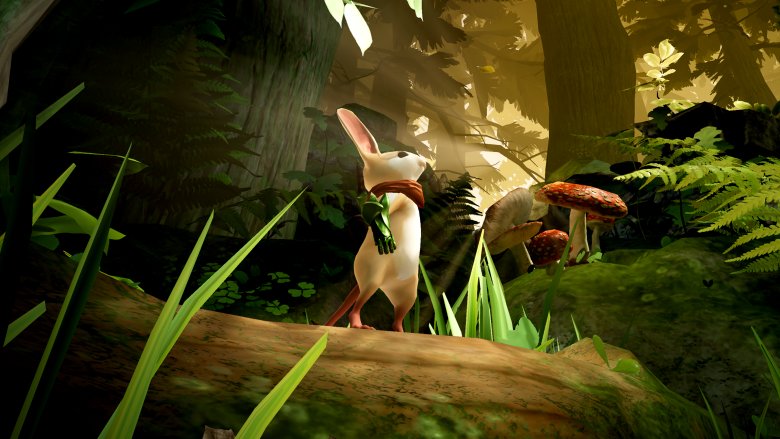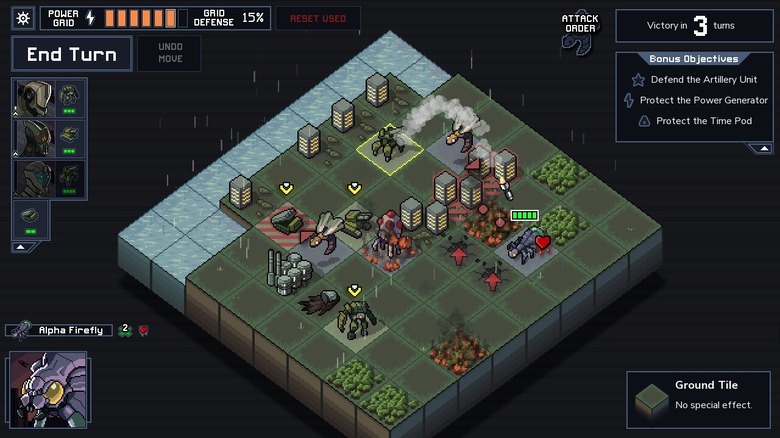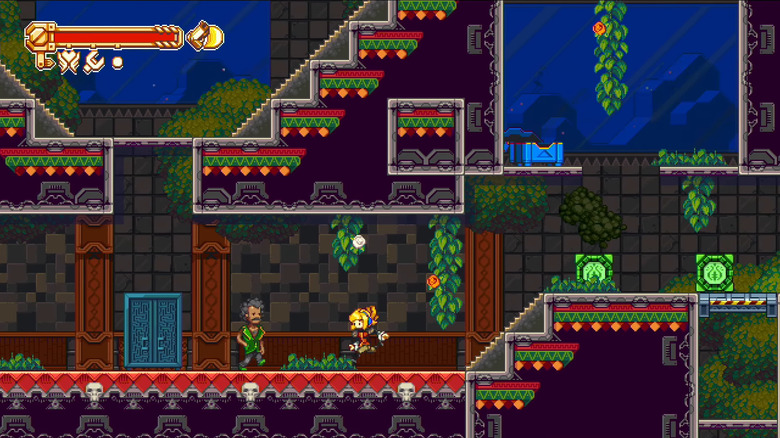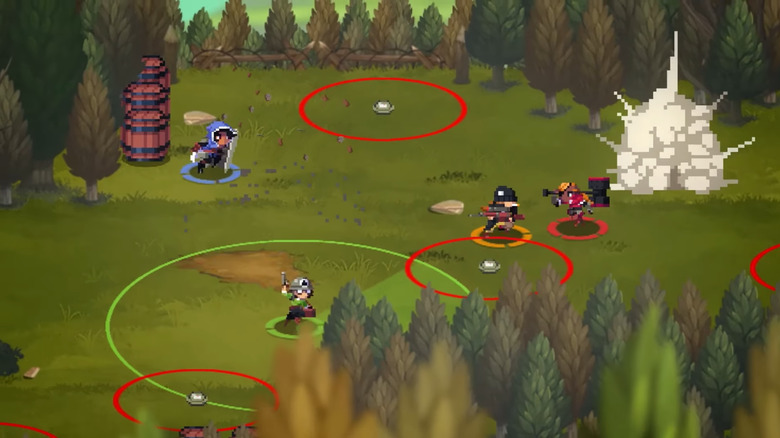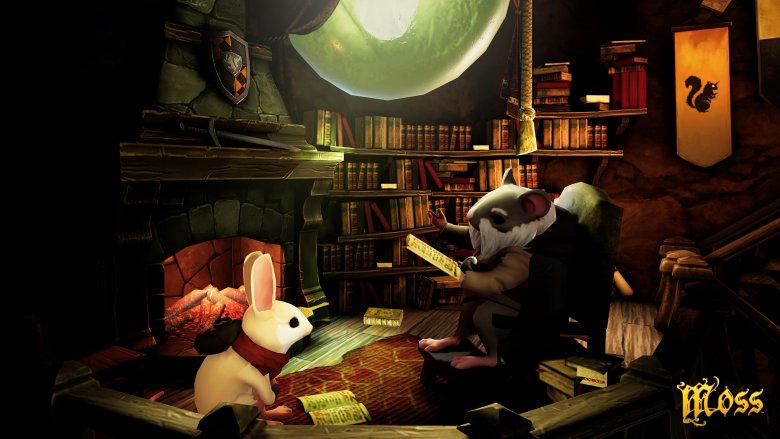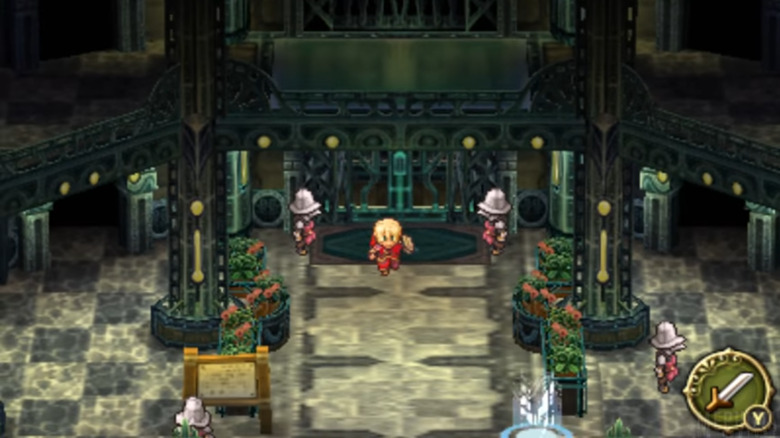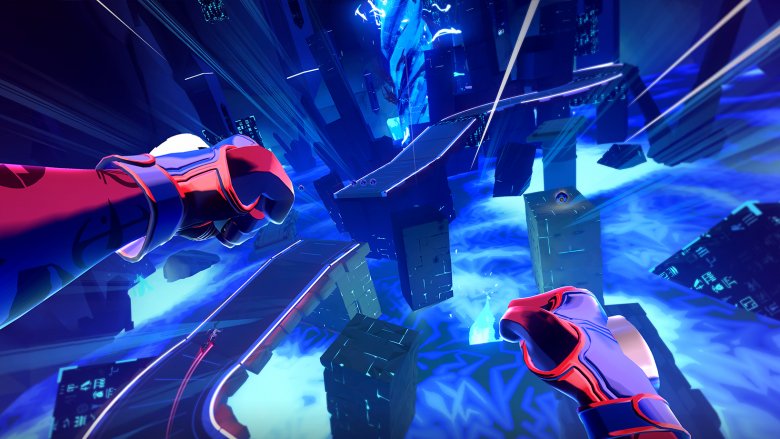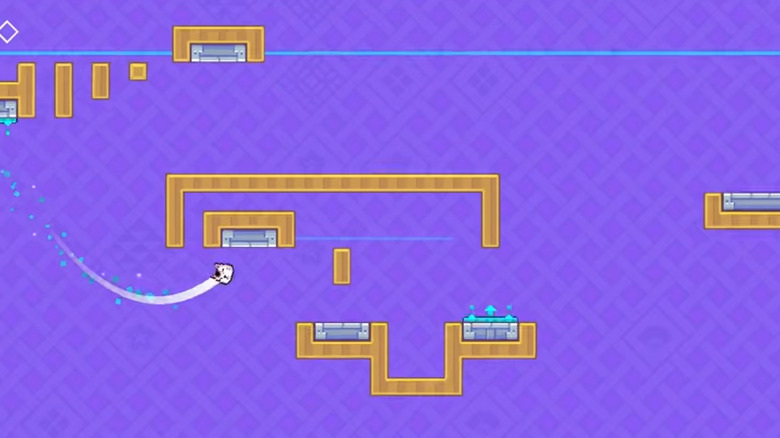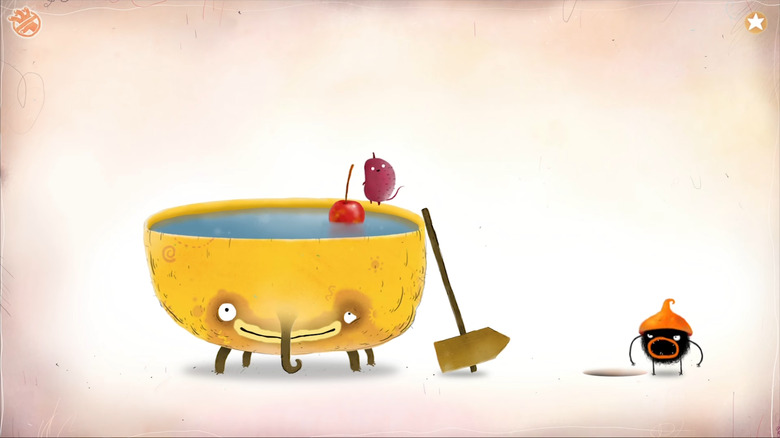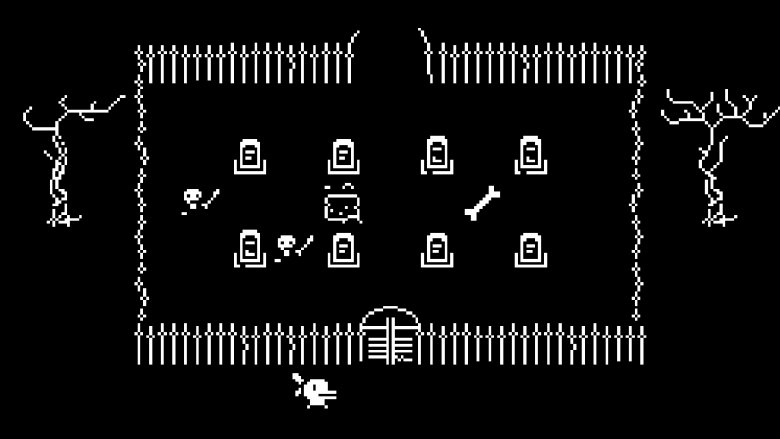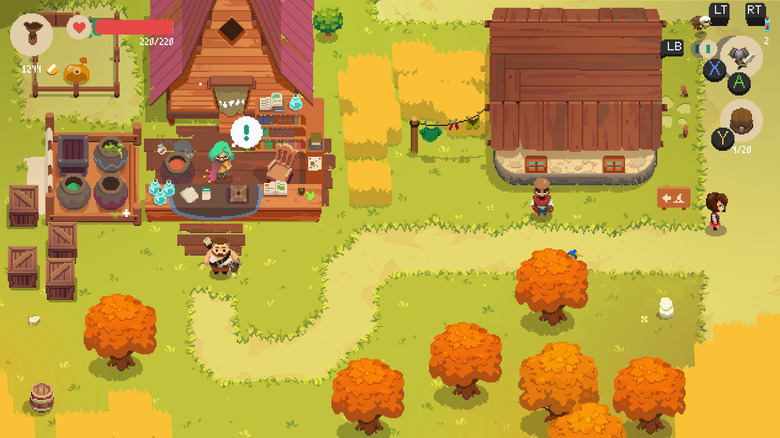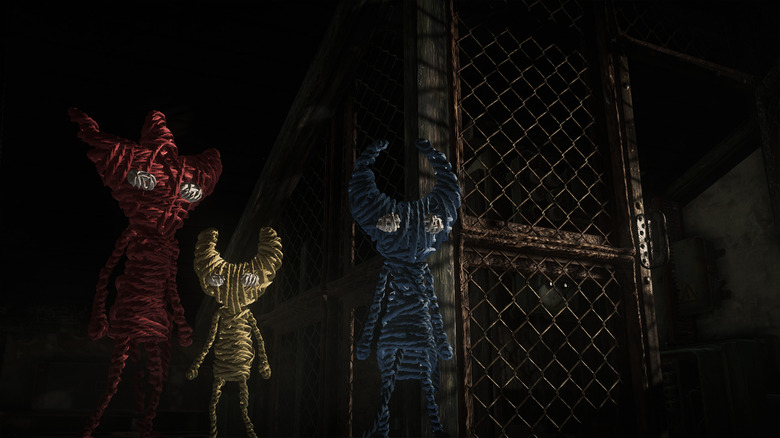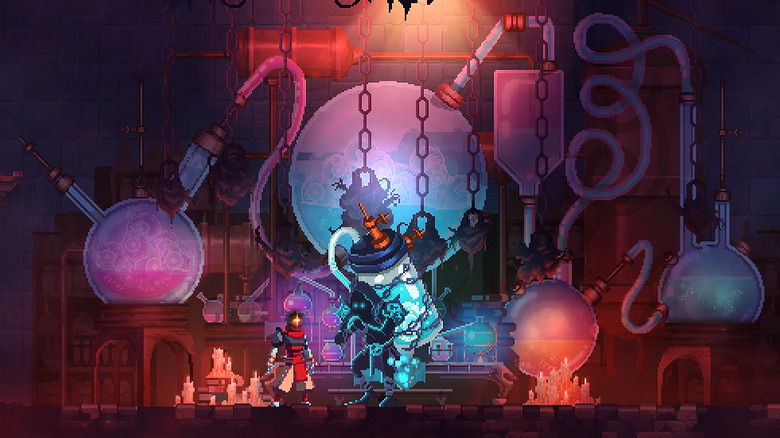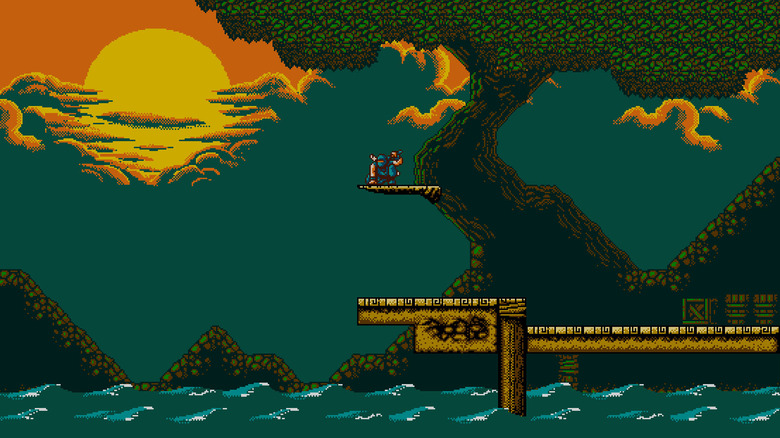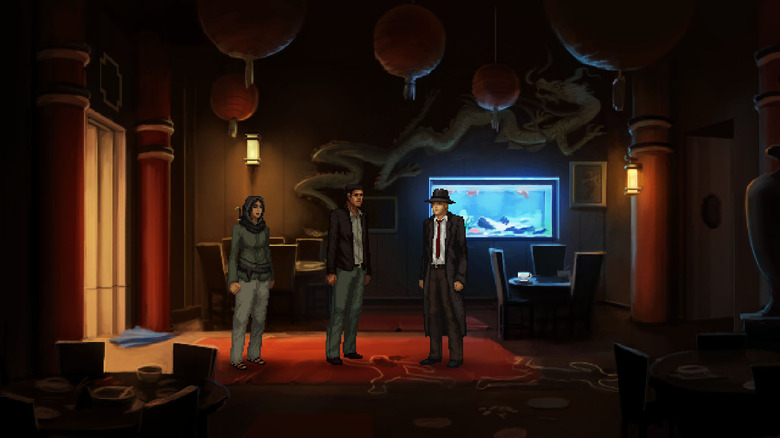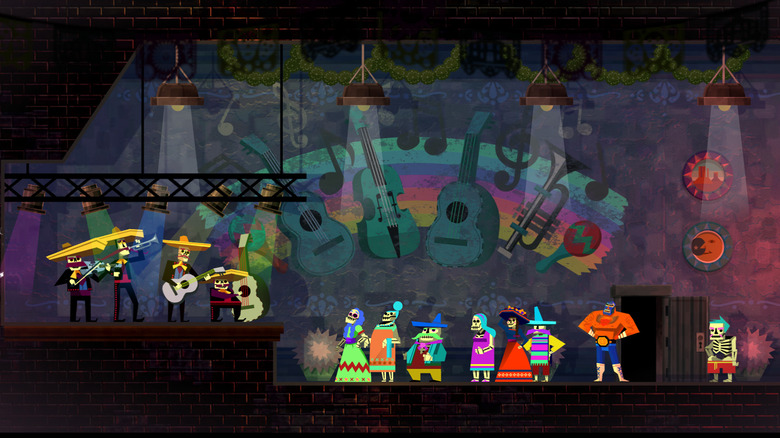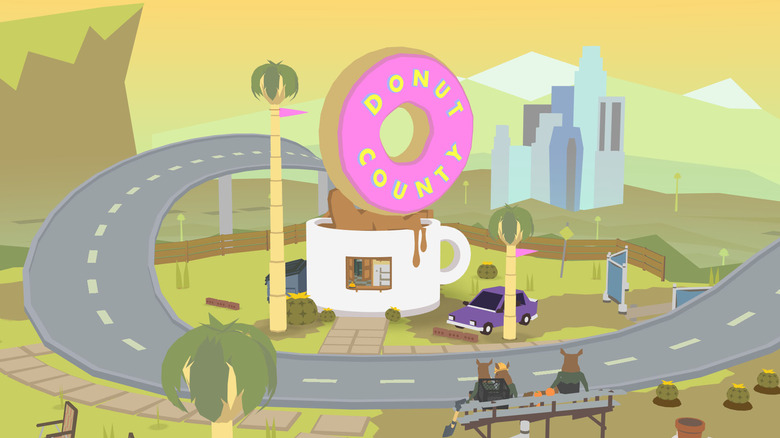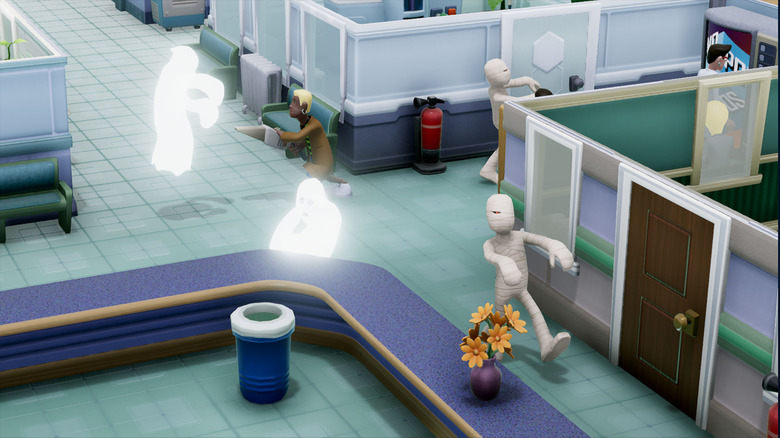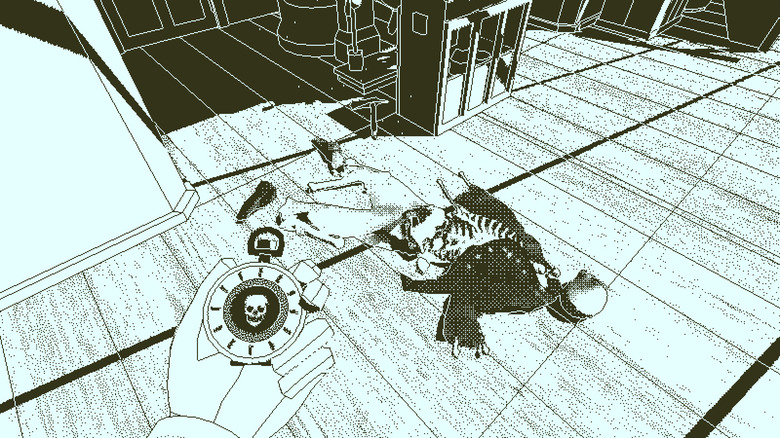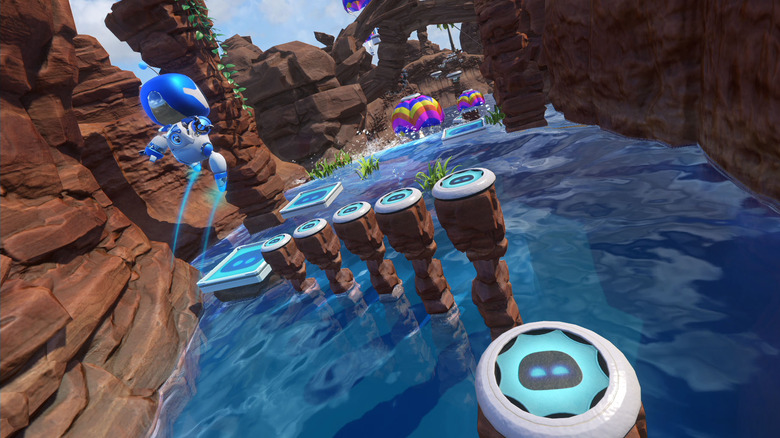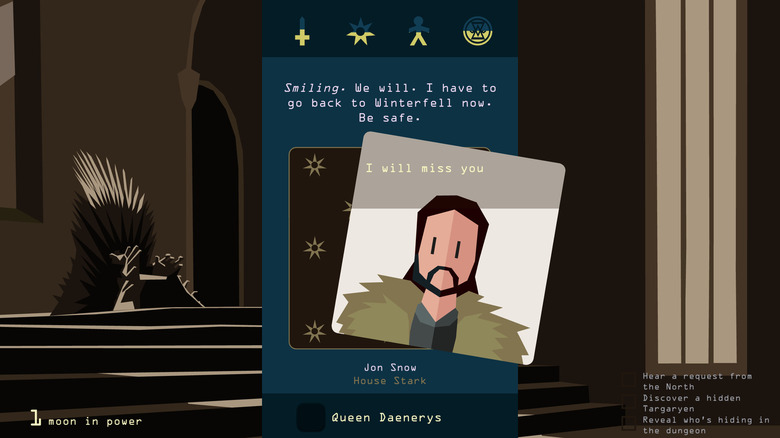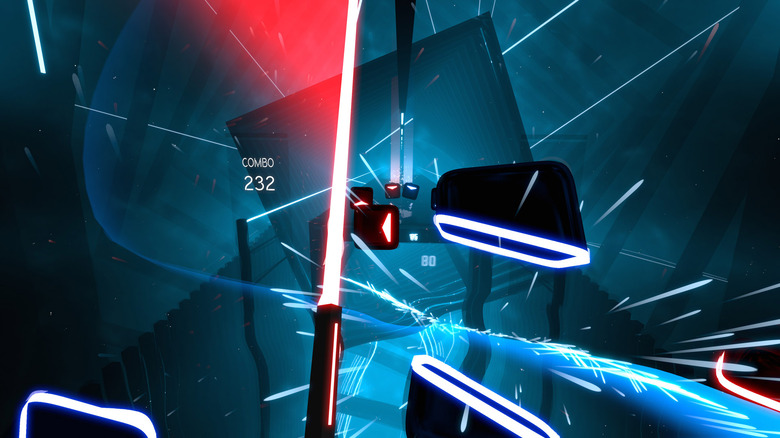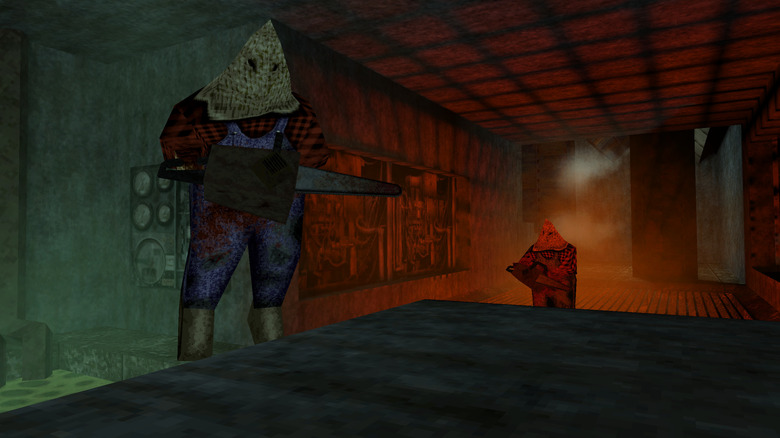Underappreciated Games You Already Missed In 2018
The number of games that release every year just keeps going up. Particularly if you look towards indie titles and Steam, the raw volume of content is just colossal, and it's only getting bigger, faster. In other words, for an indie developer, there's no good time to release a game anymore. Every single day brings dozens of shovelware titles vying for the same attention as the good stuff. That makes it harder to connect potential players with a great game, and easier for great titles to slip through the cracks and into obscurity.
As such, we've gathered a list of fantastic games that you might have missed this year. From 8-bit retro to full 3D VR, these titles run the gamut of what the medium can accomplish right now. They are innovative, fresh, and often unorthodox; you won't find any Call of Duty clones here. Maybe you're in the mood for something a little different, or you want to be part of an elite core of gamers who have played these hidden greats. Either way, here's a list of the very best that 2018 has to offer that most people never knew about in the first place.
Into the Breach brings strategic depth to ground-level
Subset Games' FTL: Faster Than Light is one of the true indie darlings of the last decade, a combination of spaceship-sim and rogue-like that challenged players to make a variety of tactical decisions under stressful conditions. For their follow-up, Into the Breach, Subset took the same tone and feel but placed it on the ground. The result is a grid-based mech tactics game in which civilian locations must be defended from attacking monsters by your own giant robots. Fortunately, it's turned out to be every bit as deep, fast-paced, and fun as its predecessor.
There are multiple islands that your heroes must defend, each one representing a different type of terrain, and with them, different gameplay twists. Ice might break on the frozen island, but the industrial island suffers from acid rain. It's up to you to figure out how to navigate these challenges, partly by pairing the correct mech and pilot. And all that's done before the combat even starts! Once the monsters arrive, you have to take the hand that you've dealt yourself and try to keep your civilians safe.
Into the Breach may look nothing like FTL, yet in its overall strategic focus, it is a very similar experience. If you loved the latter, you should check out the former. And if you missed FTL, then you still have time to hop on the new game's bandwagon.
Iconoclasts is a Metroidvania with heart, brains, and story
The two games that lent their names to the Metroidvania genre – Metroid and Castlevania – weren't exactly heavy on story. Later additions in the series would characterize the heroes and introduce plot and drama, but in the beginning, it was all about running, exploring, and gaining gear that let you run and explore more.
On its surface, Iconoclasts is a loving throwback to those early games, in both its retro art-style and non-linear layout. Yet Iconoclasts sets itself apart not merely for its excellent mechanics, but also for its emotional and uplifting story. It's a game that brought heart as well as twitchy fingers. For that matter, it brought a brain, too, since the game is filled with excellent puzzles and difficult boss encounters.
In other words, Iconoclasts had ambitions that far exceeded ripping off its source material. This is a loving update to what those earlier games might have become if they'd adhered to the original art styles. For those who hold those old games close to their hearts, Iconoclasts is a must. And for those who missed those classics, why not check out the new kid on the block? As Gamespot says, "Iconoclasts may be a callback to the style and mechanics of old-school games, but it's also a sincere and compelling adventure that anyone with respect for fantastic storytelling and 2D-action can enjoy."
Full Metal Furies brings side-scrolling brawlers into the modern era
Full Metal Furies is a deliberate throwback to the arcade-style co-op brawlers of yesteryear, in which multiple heroes smash their way through dense thickets of enemies on a side-scrolling journey. This modernized update brings not only distinct classes (in the form of the four playable characters), but also upgrade and customization options that allow for a huge variety of playstyles. And that's just within one character: synergizing the upgrades of one class with those of another can lead to whole new options to try out. Of course, not everybody has the option of playing co-op. For the gaming introverts out there, a solo mode is included, which allows a single player to swap between two heroes.
Combat is rapid-fire and relentless, mixing together both melee and ranged encounters. Taking cues from the action-RPG genre, these enemies will drop gold, which can then be spent on the aforementioned upgrades. As with Diablo and other similar series, your small heroes are vastly more powerful than any one enemy character; it's just that you'll never encounter one enemy character (save for the bosses). You're going to have to push your twitch reactions to the limit to deal with the hordes of enemies flung at you at once. But if you can, you're going to feel like an unstoppable juggernaut. Or a full metal fury, as it were.
Moss is an old-time story in a modern format
Moss from developer Polyarc presents a fairy-tale brought to life, right down to the fact that you, the player, are actually The Reader, operating inside the text of a book that you find at the game's beginning. As such, you do not merely control Quill, the mouse protagonist of the book: you also manipulate the world around Quill, using your amazing powers as a Reader. That makes Moss not only a gorgeous journey through a wonderful landscape, but also an innovative twist on the puzzle game genre.
We haven't even mentioned that it's virtual reality yet. As a PlayStation VR exclusive, Moss is somewhat limited in its reach, since only those with that specific peripheral can ever play it. But for those who have one, this is one of the standout titles available. As Polygon put it, "Polyarc sets an immensely high bar for storytelling in VR, exuding careful and deliberate artistry in every aspect — sound design, lighting, camera, visuals — to create a world worthy of straining your back to see the area in 360 degrees. In every sense, I felt like I was inside one of those beautiful, gilded storybooks."
Radiant Historia: Perfect Chronology brought a game from another time into our time (appropriately enough)
Originally released for the Nintendo DS back in 2010, Radiant Historia: Perfect Chronology is a remastered and updated take on the classic handheld for the still-going-strong 3DS. Radiant Historia itself is a Japanese RPG about time travel in a fantasy realm. As the game clearly explains, your time traveling destinations aren't completely open: you're really just bouncing back and forth between two time periods. But your actions in one timeline affect the other, and only by mastering the subtleties of time can you advance the story and save the kingdom.
While this is technically the same game as the old Radiant Historia, you'd be forgiven for not realizing it at first glance. The art has been given a complete overhaul; oh, and the voice actors are different; and the music is new, too. So, you know, literally everything that you see and hear is totally different — that's all. That said, the story and underlying mechanics are all intact, preserving what made the first game a classic in the first place.
Sprint Vector is a psychedelic speed boost
One of the defining features of VR, as opposed to traditional gaming experiences, is that it allows the player to physically interact with the game. Not just push sticks and buttons: actually reach out, manipulate, and traverse a digital environment. As the modern VR cycle has settled into place, some of these experiences have succeeded more than others. But few VR games have ever brought the raw physicality of a game like Survios' Sprint Vector. Hint: the fact that 'sprint' is in the title isn't a coincidence.
As a kind of first-person take on Mario Kart with Tron's aesthetics, Sprint Vector is all about speeding through a vibrant and bewildering racetrack. But to move in the game, you have to physically move! Imagine that! The system involves building speed by 'running' with your hands, almost like pulling yourself along ropes. In-game, you're trying to find the most efficient route towards the destination, all the while preserving your virtual momentum.
It's fast, it's fun, and it's a kinetic experience unlike anything else you'll find in gaming. Just don't expect to unwind with this game after a tough day at school or work.
Super One More Jump is all about the jumping
If this very list hasn't made it obvious, retro-style 2D platformers have been making a strong comeback lately. Fueled in part by the prevalence of platforms like Steam, iOS, and Google Play, there is more opportunity than ever for a small team to get a labor of love out to the masses. The issue, of course, is that a lot of these games start to blend together, and it's difficult for any one of them to stand out.
Super One More Jump deals with this issue not by going bigger than its competitors, but by going smaller. Which is to say, it scoped down its entire mechanical interaction to a single button. That's right: in Super One More Jump, you, as the player ... jump. That's it. There are no attacks, no special abilities, no items: just jumping. Can you even move? No! Movement is handled automatically. All you have to do is jump.
How can that possibly be interesting? Because the levels are designed with precision detail, filled not only with standard platforming elements like gaps, but various terrain features that will get in your way. As with other platformers, Super One More Jump is intended to be hard, and it will take technical mastery of the game's mechanics — which is to say, jumping — to proceed. If you fail, well, you can always try again. Just one more jump. Super.
CHUCHEL is pure joy in video game form
Many, many video games attempt to be serious. They deal with increasingly serious subject matter, and even retro-style 2D games — like a lot of those on this list — try (and sometimes succeed!) to fit in serious storylines amidst all the friendly pixels. Video games are, after all, a serious art like literature or cinema.
And then there's CHUCHEL, which doesn't care about any of that.
Bursting with pure fun from top to bottom, CHUCHEL is a very quick (around two hours) burst of laughs and energy. Minimalist in the extreme, every stage of the game is a single screen, often without much more than the main character and a couple of objects. Technically, this is a puzzle game, but let's be real: this isn't the kind of game that's going to challenge your mind. Rather, it's all about the zany things that happen once you interact with said puzzle.
Plot, you ask? Of course there's a plot! You play Chuchel, who is a ... thing, of some sort ... on an epic quest to find his ... cherry. Yes. Why? Well, why would you even ask why? Just enjoy this wonderful romp for the wonderful romp that it is. Seriously.
Minit is very limited, in the best way possible
Sometimes, a developer cooks up a simple yet brilliant idea, and builds an entire game around it. And sometimes, that idea is actually a limitation. In the case of Minit, your character lives for — wait for it — a minute. Sixty seconds, full stop. After your minute is up, you die. The end.
Except, it isn't the end, because your pixelated hero then wakes back up again in bed to live for yet another minute. And so on, and so on. The trick is that your actions from the previous life are preserved, so every minute, you're pushing the world-state, and the story, a little further forward. And every time you find a new bed, you start respawning from that new location.
So, yes, Minit is a full-fledged RPG, with exploration, puzzle-solving, and combat. You will have a grand adventure and change the world. One minute at a time. Minit never deviates from its central gimmick and never cheats the timer. A simple idea, polished to brilliance. That's indie gaming at its finest.
Moonlighter is the RPG shopkeeping sim that'll keep you up all night
In most role-playing games, you and your crew roll into town, stock up on goods at the local store, pick up a quest or two, and then head on your way with nary a thought for the villagers you just left behind. Not in Moonlighter. Instead of a world-travelling adventurer, Moonlighter casts you as Will, an RPG merchant who dreams of being something much, much more.
In Will's case, that means splitting his time between two jobs. By day, he runs the local item shop. By night, he delves into the local dungeon, collecting the goods that he puts on sale the next morning. As such, you'll need to make sure you're prepared for combat, but you'll also have to deal with more mundane concerns. While playing Moonlighter, you'll worry about pricing items correctly, making sure that your shop is friendly, inviting, and shoplifter-free, investing in the surrounding community, and much, much more. By contrast, all that questing feels downright easy.
Moonlight is a little bit Stardew Valley and a little bit The Binding of Isaac, with some dashes of Spelunky thrown in for good measure. It's not an epic fantasy story, but it's not supposed to be. Moonlighter turns a well-worn RPG trope into its own unique adventure. After Moonlighter, you'll never treat an RPG shopkeeper the same way ever again.
Unravel Two is best when you play it together
Sometimes, it feels like the big video game publishers rely a little too much on their big annual franchises — we get a new Madden, a new FIFA, and a new Battlefield almost every year — so it's always nice when they take a chance on a new property. It's even better when they do so twice. In 2016, Electronic Arts and Unravel introduced players to Yarny, an itty-bitty creature who used his yarn-based physiology to circumnavigate puzzles and dodge enemies. Just over two years later, Yarny made a surprise return at E3 2018 when EA announced Unravel Two — which happened to come out that very same day.
At first, people seemed excited. As the days went on, however, and the deluge of E3 press announcements hit, Unravel Two seemed to disappear. It doesn't deserve to. Unravel Two isn't the same game that you played and fell in love with a couple of years ago. This time around, the game's theme is "youth," not family, and Yarny moves quicker and has more moves as a result. Even more importantly, Unravel Two isn't a solo adventure. This game has two Yarnys who are connected with a thread, and who must work together, either with one player controlling both or via multiplayer co-op. The latter option is the way to go. By design, Unravel Two is simply better with a friend.
There's more life to Dead Cells than you expect
It's hard to describe Dead Cells without making it sound like a collection of indie game cliches. It carries a major Castlevania vibe, and like most other Metroidvanias, you'll be hunting through big, interconnected areas in search of the items you need to progress. It's also a rogue-like that generates a new map, new item placements, and new enemy positions every time you play. It's got combat that's inspired by Dark Souls and retro-style pixel art graphics.
Look beyond the bullet points, though, and you'll find a carefully crafted experience that's more than just a stack of buzzwords. Unlike other games of its type, Dead Cells slowly edges you out of your comfort zone and forces you to learn and explore. Unlike Dark Souls, you'll never find a reliable weapon loadout. Instead, you have to make do with what you have. Its constantly changing map makes exploration feel more dangerous and unpredictable than in games like Super Metroid or Symphony of the Night.
Best of all, as you play through Dead Cells, you'll actually see yourself getting better. The first few rounds can be brutal, but Dead Cells constantly rewards you for your efforts, and its not nearly as unforgiving as you might think. Even if you've bounced off of Dead Cells' ancestors, give this one a try. It's inviting and compulsively playable. In fact, the hardest thing about it might be putting it down.
Don't shoot The Messenger (but feel free to stab everything else)
It's easy to look at The Messenger's reveal trailer and assume you know what the game is all about. It's a Ninja Gaiden-inspired throwback with a Shovel Knight-like aesthetic and a few modern touches like a character progression tree and loot to collect thrown in, right?
Guess again. Publisher Devolver Digital might be pushing The Messenger as a simple nostalgia exercise — and, quite frankly, the game's floating platforms and pixel-perfect controls make it a fine tribute to games like Ninja Gaiden, Mega Man, and many others — but once you spend a little more time with it, you'll realize that there's a lot more going on than it seems. Want to keep the big twist a secret? Skip the next paragraph and check out The Messenger for yourself.
About halfway through the game, The Messenger takes a trip to the future, and everything changes. Not only do the graphics shift, introducing smoother, Super NES-style sprites and environments, but the game switches genres entirely. It starts as a linear platformer, and ends as a time-traveling, ninja-infused take on Super Metroid. That's not the only surprise that The Messenger has in store, either. It's not a perfect game — the second half falls victim to some unfortunate padding — but when it works,The Messenger is as satisfying as any great plot twist. It's obvious in hindsight, but while you're immersed in the experience, you never, ever see it coming.
Unexpected, unpredictable, and Unavowed
That Unavowed is great shouldn't surprise anyone who's been paying attention. Dave Gilbert's studio, Wadjet Eye Games, has been making spectacular adventure games for years. From 2006's award-winning The Shivah all the way through Gilbert's five-part Blackwell series, Wadjet Eye has found all kinds of ways to push the old-school adventure game in new directions. The gameplay might look like the same old stuff to adventure game veterans, but don't worry: Wadjet Eye isn't afraid to take risks, and the studio seems to delight in turning your expectations against you.
Unavowed is no different. Sure, it's a low-resolution 2D title, but it's also full of unique quirks, like a customizable main character and a flexible supporting cast, that helps things stand apart. It's also got a unique and surprisingly dark premise — in Unavowed, you play as a former victim of demonic possession who's out to atone for their supernaturally-fueled misdeeds — and tons of choices that'll affect how the storyline plays out.
We're not talking about just a couple of branching paths here, either. Gilbert said that, despite Wadjet Eye's small team (Gilbert is Unavowed's sole writer), he wanted Unavowed to feel as deep and flexible as a AAA BioWare adventure. Well, mission accomplished. Unavowed doesn't just have a story to uncover and puzzles to solve. It's got multiple plots hidden behind its deceptively simple exterior, and you'll have to play the game many times to see them all.
Guacamelee! 2 returns for another round of puns and pinfalls
All that you really need to know about Guacamelee! 2 is that it stars an undead luchador who suplexes skeletons. If that sounds like your kind of thing, you already know what to do: lay down your money, download Guacamelee! 2, and enjoy.
If you need a little bit more information, however, here's the deal: Guacamelee! 2 begins with the series' hero, Juan Aguacate, retired and enjoying family life. His domestic bliss doesn't last, though. Before long, evil strikes again, and Juan must put his mask back on and do battle once more. For you, that means another romp through Guacamelee!'s bright and colorful world as you help Juan learn new wrestling moves, uncover secrets, hop between the worlds of the living and the dead, and ultimately hunt down the artifacts he needs to keep Guacamelee! 2's new villain at bay.
The Mexican-themed Metroidvania was great the first time, and it's just as good the second time around. In fact, in many ways, it's better. DrinkBox Studios' writing has grown with time, and more of the games many jokes land than before. The game's interdimensional puzzles can be tough, but they're also immensely satisfying, and Guacamelee! 2's graphics are even more stunning than the first titles. By the end of the 10-hour adventure, Guacamelee! 2 risks overstaying its welcome, but if you liked Guacamelee! before, you'll like it now too, guaca-ranteed.
Takin' a trip to Donut County
Let's get this out of the way up top: Donut County is not a particularly long game. You'll be able to finish it in a couple of hours. It's not hard, either. Heck, in some ways, it's not even that original. Donut County is all about controlling a hole and using it to suck up, well, stuff. The more stuff that the hole swallows, the larger it gets, allowing it to consume even larger items. Sound like Katamari Damacy? Ben Esposito, the person who made Donut County, totally agrees.
None of this makes Donut County any less charming, of course. Maybe it's because the game is a one-man labor of love. Donut County took six years to make and went through at least one major overhaul, but Esposito stuck with it, and his passion is apparent in every well-rendered frame. Maybe it's because Donut County is legitimately funny, with its storyline that mashes up trash-gathering raccoons, donut delivery services, and smartphone apps. Maybe it's just because cramming as much of Donut County's whimsical take on Los Angeles is immensely satisfying.
Or maybe — just maybe — it's because video games don't have to be long, or challenging, or breathtakingly original to be fun. Sometimes, comforting whimsy is enough. Next time you want to cozy up with something that'll leave a smile on your face, give Donut County a shot. Chances are, you won't regret it.
When you're feeling down, Two Point Hospital will cure what ails ya'
It's hard to make a game that's legitimately funny. It's even harder to wring laughs out of major health problems. And yet, despite the odds, Two Point Hospital manages to do both. It helps that Two Point isn't a normal hospital, of course. This is a place where people come to get treated for afflictions like "lightheadedness" (i.e., the patient's head turns into a light bulb), mummification, and "mock star," which turns afflicted individuals into Freddie Mercury impersonators. Yeah, it's that kind of game.
It also helps that Mark Webley and Gary Carr, two of Two Point's co-founders, previously worked on Theme Hospital, an obvious influence. That's not a secret: Carr and Webley admit that their goal was to recapture everything that made Theme Hospital great back in the day and give it a new, modern sheen. Simulation games have changed quite a bit since Theme Hospital debuted over 20 years ago, though, and Two Point Hospital is more complex, more objective-based, and more technically advanced than its predecessor.
It's also a pretty in-depth simulation title once you get past the game's goofy aesthetics, and if you don't have much experience with this kind of game, you might find yourself getting lost pretty quickly. Stick with it. If you're nostalgic for the days when management sims didn't take themselves so seriously (or if you just like to laugh), Two Point Hospital is just what the doctor ordered.
Maritime murder is the name of the game when the Obra Dinn returns
In 1802, an East India Company cargo ship called the Obra Dinn disappeared. In 1807, it reappeared, but with a twist: every single member of its 60-person crew is missing, and it's up to you to discover why. So begins Return of the Obra Dinn, the latest game from Lucas Pope, whose 2013 puzzle game Papers, Please was an instant classic. Good news: Return of the Obra Dinn is even better.
Armed with a sketch of the crew, a passenger manifest, a mostly-blank journal, and a time-hopping stopwatch, it's up to you to both identify each and every person who set foot on the Obra Dinn as well as how they met their grisly demise. That's easier said than done. Examining corpses will take you back to the exact moment of a person's death and let you walk around the murder scene, but that's just the beginning. Observe how characters interact over time. Read the maps. Analyze accents. Exercise the power of elimination.
Indie developer Rami Ismail called Return of the Obra Dinn "detective sudoku," and there's really no better way to describe it. It's a game that makes you feel smart when you solve its puzzles. If there's one drawback, it's that Return of the Obra Dinn's two-bit graphics, which are mostly stunning, occasionally make it hard to tell what's going on. In those cases, go with your gut. You're probably right — as long as you've got the evidence lined up correctly.
Astro Bot: Rescue Mission offers a whole new perspective on 3D platformers
There aren't many people talking about Astro Bot: Rescue Mission, but there's a good reason why. The game is a PlayStation VR exclusive, and only a fraction of the 82.2 million PlayStation 4 owners out there own the peripheral. If you're one of those lucky few, however, don't let Astro Bot: Rescue Mission pass you by. The little platformer is one of the very best arguments for Sony's headset yet, and it'll get you thinking about VR platformers in a whole new way.
Astro Bot: Rescue Mission focuses on the titular robots, one of whom you'll control while you search for the others, but the little machine isn't the game's only hero. You're one, too. While you search for lost Astro Bots, you'll need to search the scenery, peeking around corners or under platforms to find them. In Rescue Mission, you're more than just a camera, though. Enemies will shoot goop at you, and if you don't dodge, it'll block your view. Occasionally, you'll need to physically headbutt foes in order to proceed.
Meanwhile, Astro jumps, runs, and swings through levels with Mario-like grace, traveling through diverse environments — volcanoes, cemeteries, jungles, and, y'know, platformer stuff — and scooping up collectibles along the way. Between levels, you can play with the Astro Bots you've rescued in their tiny spaceship. Experienced gamers will find Astro Bot: Rescue Mission a little easy, but ultimately, the game is so charming that it doesn't matter. It's just too bad that more people can't play it.
If you think you can master Reigns: Game of Thrones, you know nothing
Given its history, we're not sure why anyone would want to sit on Westeros' Iron Throne, but if you think you could do a better job than Aerys Targaryen, Robert Baratheon, Ned Stark, Joffrey, Tommen, or Cersei, Reigns: Game of Thrones is your chance to prove it. Be careful, though: ruling the Seven Kingdoms is even harder than it seems.
Like the two previous Reigns titles, Reigns: Game of Thrones combines a kingdom-running simulation with a dating app. When your subjects ask you questions, swipe left to say yes, and right to say no. This time, however, you'll be interacting with characters ripped directly from HBO's uber-popular fantasy drama. It's a great fit. In fact, when François Alliot first pitched Reigns to Devolver Digital, he described it as "Tinder meets Game of Thrones." An official licensing deal is the next obvious step.
Like George R.R. Martin's most famous creation, the world of Reigns can be absolutely brutal. In Reigns, you must contend with the needs of the military, the people, the church, and the treasury. None of those factions get along, and if give any one too much support — or too little — you'll find your reign brought to a quick and sudden end. That happens a lot. Think that the show has a high body count? Just wait.
Beat Saber is a force to be reckoned with
Rock Band with lightsabers? Yeah, okay.
There isn't much to Beat Saber, Beat Games' ultra-addictive rhythm game. You've got two electronic swords, and you need to use them to physically slash away at blocks that come barreling down the pipe in time to the game's pulsing electronic soundtrack. Easy, right?
Eh, maybe not. While Beat Saber starts out simple enough, it won't be long before you're flailing your controllers all over the place, trying to cut blocks at the right angle, avoid deadly mines, and rack up a high score. It is, in a word, madness. It's also remarkably addictive and infinitely compelling. After all, there's a reason why Beat Saber became the highest-rated game on Steam the week that it hit Early Access. It's that good.
It'll be getting better, too. Beat Saber is still in development, and a multiplayer mode, a level editor, a greater variety of blocks (including moving cubes) and more are still on the way. But don't wait for those features to arrive. Beat Saber is already one of the best arguments out there for picking up your own VR headset. Lightsabers might be the name of the game (literally), but you don't need to be a Star Wars fan to enjoy this one. If you like good games, that's more than enough.
Dusk sheds new light on some old favorites
Back in the '90s, first-person shooter players had it rough. Enemies moved fast and hit hard. Health didn't regenerate. Levels were winding, abstract affairs decorated with low-resolution textures. Taken all together, some stages seemed explicitly designed to make you lose all sense of direction. Guns were powerful, but ammo was hard to come by. Games like Doom and Quake were challenging, and once the credits rolled, you felt a real sense of pride. There was no doubt that you'd earned it.
Recapturing that feeling is what Dusk is all about. Designed primarily by David Szymanski, Dusk is both a love letter to early FPS games and a subtle refinement of the genre itself. If you're looking for retro-style graphics or old-school multiplayer deathmatches, you'll find those here. But Dusk has new concepts too, like the ability to perform mid-air acrobatics, and many of the more dated parts of id Software's original creations have been jettisoned in favor of more palatable and modern ideas.
So don't think of Dusk like a cover band. Some of the sounds might be familiar, but the tunes are all new. Dusk is lean and mean and bursting with energy, and if this kind of game is your jam — or if it used to be — you might find that Dusk is one of the best first-person shooters you've ever played. And if you're still not sure if you'll like Dusk? Well, there's only one way to find out.

